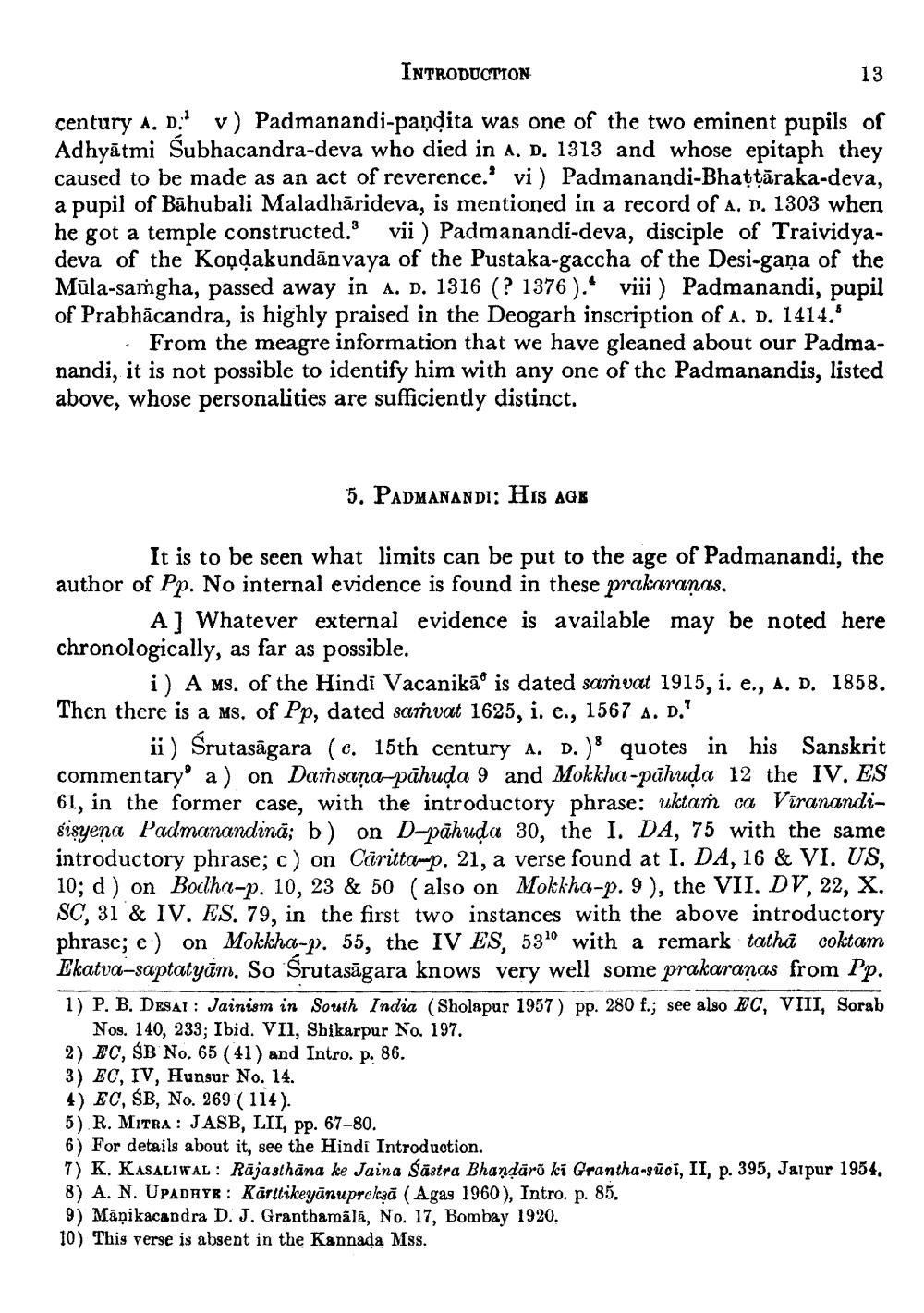________________
INTRODUCTION
13
century A. D: v) Padmanandi-pandita was one of the two eminent pupils of Adhyātmi Subhacandra-deva who died in A. D. 1313 and whose epitaph they caused to be made as an act of reverence." vi) Padmanandi-Bhattāraka-deva, a pupil of Bahubali Maladhārideva, is mentioned in a record of A. D. 1303 when he got a temple constructed. vii ) Padmanandi-deva, disciple of Traividyadeva of the Kondakundānvaya of the Pustaka-gaccha of the Desi-gaña of the Mūla-samgha, passed away in A. D. 1316 (? 1376). viii) Padmanandi, pupil of Prabhācandra, is highly praised in the Deogarh inscription of A. D. 1414,
· From the meagre information that we have gleaned about our Padmanandi, it is not possible to identify him with any one of the Padmanandis, listed above, whose personalities are sufficiently distinct.
5. PADMANANDI: HIS AGE
It is to be seen what limits can be put to the age of Padmanandi, the author of Pp. No internal evidence is found in these prakaranas.
A] Whatever external evidence is available may be noted here chronologically, as far as possible.
i) A ms. of the Hindi Vacanikā® is dated samvat 1915, i. e., A. D. 1858. Then there is a Ms. of Pp, dated samvat 1625, i. e., 1567 a. D.'
ii) Śrutasāgara (c. 15th century A. D.) quotes in his Sanskrit commentary a) on Daṁsana-pāhuda 9 and Mokkha-pāhuda 12 the IV. E 61, in the former case, with the introductory phrase: uktam ca Viranandisisyena Padmanandinā; b) on D-pähuda 30, the I. DA, 75 with the same introductory phrase; c) on Cärittamp. 21, a verse found at I. DA, 16 & VI. US, 10; d) on Bodha-p. 10, 23 & 50 (also on Mokkha-p. 9), the VII, DV, 22, X. SC, 31 & IV. ES. 79, in the first two instances with the above introductory phrase; e) on Mokkha-p. 55, the IV ES, 5310 with a remark tathā coktam Ekatva-saptatyām. So Śrutasāgara knows very well some prakaranas from Pp. 1) P. B. DESAI: Jainism in South India (Sholapur 1957) pp. 280 f.; see also BC, VIII, Sorab
Nos. 140, 233; Ibid. VII, Sbikarpur No. 197. 2) EC, SB No. 65 (41) and Intro. p. 86. 3) EC, IV, Hunsur No. 14. 4) EC, B, No. 269 (114). 5) R. MITRA: JASB, LII, pp. 67-80. 6) For details about it, see the Hindi Introduction. 7) K. KASALIWAL: Rājasthāna ke Jaina Šāstra Bhandāro ki Grantha-sūci, II, p. 395, Jaipur 1954, 8) A. N. UPADHYR : Kāritikeyānupreisā ( Agas 1960), Intro. p. 85. 9) Māņikacandra D. J. Granthamālā, No. 17, Bombay 1920. 10) This verse is absent in the Kannada Mss.




